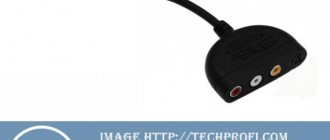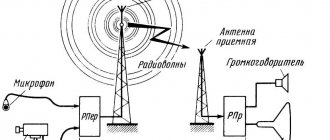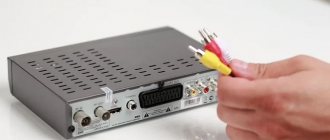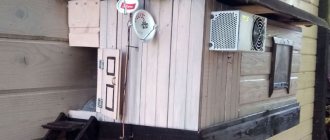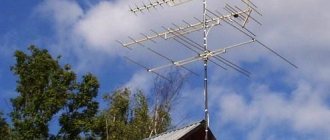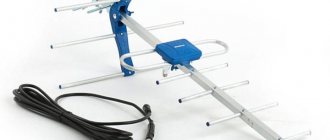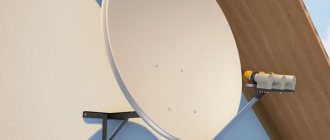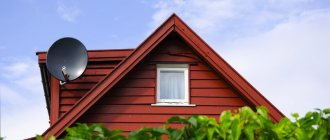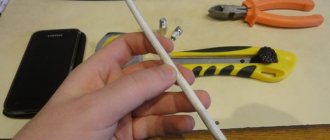Having worked as a television installer for more than ten years and installed hundreds of television antennas, both in the country and in the city, I want to share my experience with you. In the article I will tell you what kind of television antenna is needed in what area it will work. What equipment may be needed. Everything written in this article is based on personal experience. In practice, installing a television antenna is not difficult. The main thing is to choose the right equipment.
Where to start installing an antenna
Where does the installation of antennas begin? As a rule, we need to decide what kind of television we want to watch:
- Digital terrestrial television (20 channels free);
- Satellite (there are almost no free federal channels, only if collected from several satellites);
- ipTV (many free and paid channels for a nominal fee of 30-60 rubles per month, more than 150 channels);
- Cable (depending on the provider; usually some channels are broadcast for free).
ipTV and cable are more likely for the city, but with the development of high-speed Internet recently, many are beginning to consider ipTV as an alternative to satellite television. There are more channels, the subscription fee is lower or completely absent. Here we will look at how to properly install an antenna in the country and in the city for dvb-t2 digital television (I will describe the installation of the satellite in another article). We've dealt with television, let's move on.
Connecting the antenna to the TV
Connecting an HDMI cable to a digital TV tuner
If you have a built-in DVB T2 receiver
- Find a special input on your TV for connecting an external antenna. It is usually signed Ant In.
- Connect the cable coming from the antenna to this connector. During this time, the TV must be turned off for safety reasons.
- Turn on the TV and activate the digital tuner in the settings.
- Perform automatic channel search.
- Enjoy watching.
When using a digital tuner set-top box
- Connect the cable coming from your antenna or amplifier to the antenna input on your set-top box.
- Connect the set-top box to the TV. Ideally, this should be an HDMI cable, as it provides the highest quality video signal. If this interface is not available, connect the two devices using traditional analog connectors, the so-called tulips. There should be 3 of them, they are indicated in different colors. Usually it is yellow, red and white. Two of them are audio connectors, while the third is video. Most often, the connectors on both the TV and the set-top box have the same color designation, so it is quite difficult to confuse them.
- Turn on the TV and use the remote control to select the external signal source to which the tuner is connected. This can be either HDMI or AV. It all depends on the connection method.
- Search your set-top box automatically for TV channels or configure each one manually. There is no need to configure anything on the TV.
Digital tuner box
Types of antennas for receiving TV signals
I will not describe all types here, but will recommend only those that we use on installations and that have not let us down. Due to the fact that analog television is ceasing to exist, we will consider antennas for digital television simply in the UHF range. We don't need meter waves (MV).
You may be interested in: Connection diagram for several TVs without an amplifier
Digit 6 (Cifra 6) manufactured by Antex (Ekatirenburg). You can install this antenna in a country house not far from the city, up to about 15 km. under optimal reception conditions and in the city (compact, small size). Gain 6 dB.
Number 9 (Cifra 9) manufactured by Antex (Ekatirenburg). Like the previous one, it can be used for installation in the city and outside the city up to 25-30 km under optimal reception conditions. Gain 9 dB.
Digit 12 (Cifra 12) manufacturer Antex (Ekatirenburg). We use it outside the city up to 35-40 km. under the same conditions. There is no point in using it in the city unless you connect several apartments to television. Gain 12 dB.
From practice! The installation of Digit 12 at the dacha was carried out, 67 km from the tower in a straight line (the village of Mechurinskoye in the Leningrad region) the house was located on a hillock plus the height of the house was about 14 meters. The antenna was located almost above the forest (optimal conditions were obtained). As a result, the first 10 channels out of twenty worked without an amplifier, but when the weather changed, the picture crumbled. I wanted 20 channels and a more stable signal, since three TVs were connected. We installed the Alcad 200l amplifier, the problem was solved. At the same facility, only 1 multiplex worked stably at number 9 plus amplifier.
LP 14 (LANS). Log-periodic production in China, but done well. Gain factor 12-14 dB. We use it only outside the city (the traverse is more than a meter long). The distance to the tower is up to 40 km. Works well when the house is located in a forested area.
Vector AR-806 is an analogue of Televes, three times cheaper, but not inferior in parameters. Gain 14-17 dB. We use on average up to 50 km.
Optimal signal reception conditions are when there are no obstacles on an imaginary straight line from the antenna installation site to the transmitting transmitter.
All antennas considered are passive. Install a TV signal amplifier as a last resort. The first thing is to achieve the purest signal possible, and then amplify it if necessary. An amplifier may be required if you will be connecting multiple TVs. TV connection diagrams can be found in this section (I hope I drew it clearly). All working schemes have been tested through personal experience.
Basic concepts of a potential master
Even if we are dealing with a traditional television antenna, and in such cases, installation requires at least minimal knowledge and skills. Satellite equipment is much more complex in comparison with conventional TV reception.
If for conventional equipment there are two main concepts - cable and plug, a system where satellite reception is carried out has a number of technical concepts:
- TV satellite.
- Satellite antenna.
- Converter.
- Multi-feed holder.
- Bracket.
- Receiver.
Let's take a closer look at each of the components of satellite equipment.
A television satellite is the source of the signal that needs to be received by the antenna. Accordingly, in order to receive a constant signal, it is necessary to constantly point the antenna towards the satellite.
A device in geostationary orbit of the Earth is, in fact, a standard space satellite, but the main functionality of such a device is broadcasting a television signal
There are different satellites and different antenna designs, but the tuning principle is almost the same for all.
For this television reception technology, a satellite antenna is used, which is a disk “dish” of different diameters, equipped with a conversion device - converter .
Part of the equipment is an antenna that ensures reliable reception of a television receiver signal from a satellite. Considering the frequency of the transmitted signal, the antenna looks slightly different than traditional reception designs
This is a module of small geometric dimensions, usually cylindrical in shape, attached directly to the “front” part of the satellite antenna.
The disk antenna has a special design that allows you not only to receive a television signal, but to additionally concentrate it and direct it to one point - namely to the converter. It is, in fact, a primary signal amplifier, from which the signal is sent via cable to the receiver.
One of the components of a satellite dish that needs to be given special attention during installation, ensuring a high degree of tightness of the structure
A special rod holder is used to secure the module. A device called a “multifed holder” is the same rod holder, only slightly modified. Allows you to place several converters to work with different satellites.
The bracket is, in fact, a mechanical structure that is assembled from component parts and fixed in the intended installation location of the satellite dish. As a rule, such a place is the wall of the building, less often the roof truss system.
The so-called “multifed” is, in simple words, an extended rod. This is a holder for several converters at once, designed to receive signals from different satellites
The electronic module for processing the received television signal, followed by displaying information on the screen of the television receiver, is called a receiver .
There are various designs of receivers depending on the manufacturer. However, a specific manufacturer, as a rule, completes the equipment taking into account the matching of the antenna and the device.
The design of the bracket involves more than just a conventional stationary mount. The mechanical part has a simple but quite effective vertical and horizontal shift system
Therefore, it is quite problematic to coordinate any receiver (receiver) with any “non-native” antenna. This point should be taken into account before installing and configuring a satellite dish for a modern TV in your home.
The receiving module is also a “receiver” of the signal, which does not need to be installed like a satellite dish, but requires some settings on the part of the end user
TV antenna for a summer residence: where and how to install
Before you begin installing an antenna in a private home, determine the location of the nearest tower or repeater. You can do this by indicating your location on the CETV coverage map
You may be interested in: CETV coverage map
Once you know the mileage, you can buy equipment. What you will need to install outdoor antennas:
- Antenna, if you follow our advice, then one of the listed;
- Coaxial cable (RG 6 professional steel, SAT 703, SAT 50 copper);
- F connectors, TV plug (according to the number of connections);
- Lightning protection for the cable (optional, but if you want to install the antenna on a mast, it’s better to install it; the price is 300-350 rubles)
- Bracket or mast;
- Ties and clips for cable fastening;
- Device, digital set-top box with TV or TV with dvb-t2 support for setup;
- TV signal amplifier and dividers (if required).
- Fasteners for bracket or mast. Decide for yourself which fasteners will suit you (screws, studs, anchors, etc.).
- Hammer or drill, drill or drill with a diameter of 8 mm. under the cable. A knife for stripping cables, wire cutters and, depending on the circumstances, what may be required.
Everything about the equipment. You determined where to go from the map. Next, we will consider options for installing television antennas.
Which antenna to choose
Before you can set up an antenna, you need to select it. A professional approach to installation involves measuring the signal level using a portable sensor. It will be very useful in areas with dense buildings, where the signal comes not only directly from the repeater, but is also reflected from the terrain or comes from several repeaters at once. After obtaining the signal characteristics, it is necessary to study the instructions for the antenna so that the quality of reception is guaranteed.
If it is not possible to use a portable sensor, then using general recommendations, you can select an antenna by trial. The recommendations are simple. For an apartment in an area with sparse buildings, a regular but high-quality indoor antenna for DVB-T2 is suitable. In densely built areas, it is necessary to use an indoor antenna with a signal amplifier. In open areas, that is, in cottage villages and dachas, it is already necessary to use an external antenna. Taking advantage of the free product replacement option in the store, you can independently configure several antenna models until you find the right one.
Antenna mounting options
In fact, there are not many options for installing an antenna in a dacha, there are only two:
- Installation on the facade of the house;
- Installation on a mast.
Some are installed in the attic or in the house (this will also work if the signal is strong and the roof is not made of metal).
Installation on a mast
The mast was mainly used for installing collective antennas and under difficult reception conditions. For example, if the house is located in a lowland, in the direction towards the tower there is a hill, a building, a mountain, etc. Also when you need to install several pieces (digital, satellite and Internet or cellular communications).
From practice! 95% of installations are done without a mast, outside on the facade of the house.
There are two ways to install the mast:
- On brackets for mounting on the facade of the house.
- With guy ropes and a support for the roof of the house.
Façade installation
Installing the antenna on the facade using brackets is much easier than fiddling with the mast. It is not necessary to mount it as high as possible. This rule applied to analog television. At that time, television towers were located only in large populated areas. And the farther from the tower we got, the worse the signal we got. In order to somehow watch TV, we had to install the terrestrial antennas as high as possible. With the advent of digital television, many repeaters were built and the coverage area expanded significantly. So most of it is mounted on brackets.
You may be interested in: How to connect a digital set-top box to your TV
Installation in the city
For urban conditions, there is the concept of a reflected signal - this is when you do not have direct visibility of the tower, but there are many buildings around where the signal can be reflected. In some cases, you can get by with a passive indoor antenna for a strong signal or with an amplifier for a weak signal.
There are shadow areas where the signal is critically low or non-existent. In such a place, even “dancing with a tambourine” will not help to attract a signal. In this case, you have four options:
- try to negotiate with neighbors whose windows face the other direction;
- negotiate with the HOA, housing and communal services and install it on the roof where there is a signal;
- refuse installation and use cable or IPTV.
- You can also consider satellite TV if the windows face south and there are no obstacles in front for the signal to pass through.
You may be interested in: Setting up a digital antenna
Fine-tuning signal quality
You can, of course, accurately capture a signal of the proper strength and quality yourself, without the use of additional equipment. However, in difficult reception conditions, it is best to use a special device for tuning over-the-air antennas. What is such a device? Usually this is a small box with a mechanical dial or liquid crystal screen that displays the signal strength. On one side the power is connected, and on the other there is an input for connecting the antenna cable. Since adjusting the antenna based on the visual perception of the image on the screen is not the most reliable, such a device will greatly simplify your task.
- Take the device and connect the antenna cable to it, and also supply power either from the built-in batteries or from an external battery pack.
- Turn the antenna towards the receiver. If the direction is correct, the device will immediately begin to emit a sound signal, and the numbers or arrow will appear on the scale.
- If the device shows insufficient signal level, change the position of the antenna by turning it to the side, raising it higher or lowering it lower. Achieve maximum signal performance.
- Turn off the device, secure the antenna and you can start setting up the equipment.
Prices and companies
In any case, a specialist will be able to install the antenna faster and better than an amateur.
Also, many antenna owners do not want to “play” with its installation, and therefore we suggest considering how much it costs to set up and install a satellite dish in different cities of Russia and Ukraine. Price table, cost of installing an azimuth satellite dish 43 cm, 0.55-0.6:
| City | Price, rubles |
| Almaty | 2400 |
| Barnaul | 2500 |
| Vladivostok | 2500 |
| Volgograd | 2400 |
| Donetsk | 2500 |
| Rostov-on-Don | 2400 |
| Ekaterinburg | 2400 |
| Zaporozhye | 2500 |
| Irkutsk | 2400 |
| Karaganda | 2300 |
| Kyiv | 2500 |
| Minsk | 2500 |
| Moscow | 2500 |
| Odessa | 2400 |
| Permian | 2400 |
| Samara | 2300 |
| Saint Petersburg | 2500 |
| Saratov | 2400 |
| Kharkiv | 2400 |
| Ulan Ude | 2400 |
| Novosibirsk | 2500 |
Independent and professional setup of the satellite antenna Yamal (Yamal 201 90E), Tricolor TV Siberia (Tricolor), HotBird (HotBird), GAL, Orion, Samsung DSB-S300V is carried out within several hours, under normal weather conditions. The most popular models now are: SatelliteAntennaAlignment (Germany), ABS-1, LMI 75, ExpressAM2 80, Turksat 1C/2A 42E, Satgate, StrongSRT90 Multisat, HDHumaxVAHD-3100S, PBIDVR-1000S, Openbox®SF-20.
